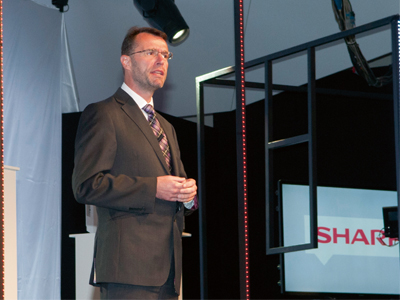Jason Cort, European director of product planning and marketing
Along with some 850 dealers, customers and partners, Digital Printer was invited to Sharp’s Inspire Expo 2015 in Malta, where light production printing was just a part of the company’s messaging.
By its own admission, Sharp is not a leading light of the production printing world, but it does have printing systems that fit into the light production market space in both colour and mono, and these formed a part of the company’s recent Inspire Expo 2015.
Both the colour and mono flagship models were on display, with the mono printers (the MX-M1055 and MX-M1205 running at 105 and 120 pages per minute respectively, due for launch in Q2 2016) proudly displaying a new Sharp 15 x 4 inch graphical user display. The light production systems also now all have a Fiery controller, and the colour systems, which were initially codenamed ‘Polaris’ but now are simply referred to as the MX6500 and MX7500, running at 65 and 75 pages per minute, have been noted for their ability to print edge to edge.
Predominantly, Sharp sees its light production systems mostly being attractive to the corporate CRD sector, and it believes that customers there have a wealth of different needs, of which print is just one, that Sharp can cater for through its portfolio of document and visual solutions. At Inspire Expo, these included display screens, interactive whiteboards and cloud-based software for the storage, collaboration and management of documents.
It comes down to communication of information, according to Alexander Hermann, vice president of Sharp Information Systems Europe, who said in his keynote address that ‘many of our competitors focus on the technology of IT, yet our customers focus on information, on sharing knowledge to create inspiring ideas’.
Speaking to Digital Printer later, Mr Hermann was almost disarmingly honest as he expanded on this theme. He said: ‘We never said to the market that we want to become the leading provider of production equipment, but we want to make the products better than they are today, so that we can ideally lead the market in terms of technology, if not market share. But it’s not do or die. We can afford to make a good product and a good proposal to the customer.
‘Do we bring something different? Honestly, no. We fit all the basic requirements. If a customer wants to choose purely on hardware specifications, we are a contender. We can at least compete with other companies in the market, and we may have some features that are interesting to some customers. What’s more interesting is the overall proposal. The basic unit of currency is not the click. We are helping to move informtion from A to B. We have more knowledge and capabilities, including R&D and manufacturing , than most or all of our competitors. Some may have more or better products in the toner on paper category.
‘I believe that by looking at all of what a CRD needs in a corporate enivronment today, information in, information out, and by widening the playing field, we can have a better advantage. Our industry is still thinking about the click but the basic unit of currency, I believe, should be information.’
Jason Cort, European director of product planning and marketing, explained a little about Sharp’s approach to the light production market, which is via both a direct route and and indirectly through the channel.
‘Direct has grown through acquisition,’ he said. ‘IOT was a Ricoh reseller until we acquired it about three years ago. That allowed us to grow our business quite rapidly in the UK. However, we have maintained a strong dealer channel as well.
When we moved into the production market space we had to recruit dealers with expertise in that field. It has taken some time to get there and to develop our own expertise to get the right partners. We have recognised that it’s a different market for us and we have had to bring in people that are familiar with it and can sell and demonstrate those products.’





